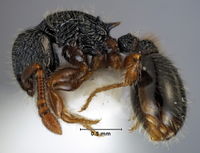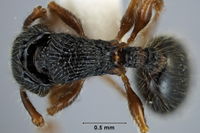Myrmecina australis
| Myrmecina australis | |
|---|---|

| |
| Scientific classification | |
| Kingdom: | Animalia |
| Phylum: | Arthropoda |
| Class: | Insecta |
| Order: | Hymenoptera |
| Family: | Formicidae |
| Subfamily: | Myrmicinae |
| Tribe: | Crematogastrini |
| Genus: | Myrmecina |
| Species: | M. australis |
| Binomial name | |
| Myrmecina australis Wheeler, G.C. & Wheeler, J., 1973 | |
This is the southern-most species of Myrmecina found in Australia. It occurs in a range of habitats from dry sclerophyll woodlands through wet sclerophyll, Nothofagus and Dicksonia forests and into rainforest. Most specimens have been found in leaf litter samples or under rocks. (Shattuck 2009)
Identification
Shattuck (2009) - Basal segment of funiculus shortened and expanded laterally, with strongly convex sides and appearing essentially spherical. The shape of this antennal segment is highly distinctive and will separate this species from all others known from Australia.
Keys including this Species
Distribution
Latitudinal Distribution Pattern
Latitudinal Range: -26.85° to -35.58333333°.
| North Temperate |
North Subtropical |
Tropical | South Subtropical |
South Temperate |
- Source: AntMaps
Distribution based on Regional Taxon Lists
Australasian Region: Australia (type locality).
Distribution based on AntMaps
Distribution based on AntWeb specimens
Check data from AntWeb
Countries Occupied
| Number of countries occupied by this species based on AntWiki Regional Taxon Lists. In general, fewer countries occupied indicates a narrower range, while more countries indicates a more widespread species. |

|
Estimated Abundance
| Relative abundance based on number of AntMaps records per species (this species within the purple bar). Fewer records (to the left) indicates a less abundant/encountered species while more records (to the right) indicates more abundant/encountered species. |

|
Biology
Castes
Nomenclature
The following information is derived from Barry Bolton's Online Catalogue of the Ants of the World.
- australis. Myrmecina australis Wheeler, G.C. & Wheeler, J. 1973a: 34 (l.) AUSTRALIA (attributed to Forel). Shattuck, 2009a: 6 (w.).
Type Material
- Syntype, 4 larvae, New South Wales, Australia, Museum of Comparative Zoology.
Unless otherwise noted the text for the remainder of this section is reported from the publication that includes the original description.
Taxonomic Notes
Shattuck (2009) - The name australis was first published by Wheeler and Wheeler (1973) when describing larvae received from B. B. Lowery from an unspecified locality in New South Wales. The name was attributed to Forel, indicating that the Wheeler’s did not intend to establish a new species. It was treated as a nomen nudum until it was correctly recognised by Bolton (1995) that the larval description met the requirements of the ICZN to be treated as an available name. Unfortunately it is difficult to determine the identity of this taxon as species-level differences among ant larvae are minimal and few species are represented by the larval stage.
The origin of the name seems to lie with Lowery. Lowery labelled a number of his collections as being “Myrmecina australis Forel,” this material ranging from northern Queensland to southern New South Wales. It appears that he sent specimens from New South Wales to the Wheeler’s which were labelled as being “Myrmecina australis Forel.” They accepted this name without checking its validity, the result being that they inadvertently created a new available name. While we don’t know the exact collection locality for these larvae, the vast majority of Lowery’s collections were from central and southern New South Wales and lie within the range of this taxon and no other. It is therefore highly likely that these larvae belong to this species.
This name could be treated as species inquirenda, arguing that there is no direct evidence to associate it with workers and therefore no positive way to relate it to the worker-based taxonomy developed in this study. And while its identity could be determined with DNA barcoding methods, it seems unlikely that currently available technologies will recover significant intact DNA from 40-year old larvae stored at room temperature. Unfortunately, this course of action would leave this name unplaced within the taxonomy developed here, a less than desirable situation.
To avoid having M. australia unplaced, and based on the high likelihood that it belongs to this taxon, this name is here accepted for this taxon rather than proposing a new name. As long as the taxon concept proposed here is accepted then this nomenclature will remain stable. If, however, this species is found to represent more than one taxon then the status of this name can be re-examined and resolved or it can be treated as species inquirenda and new names proposed for this and any additional taxa discovered.
Description
Worker
Shattuck (2009) - Antennal scapes smooth or with low ridges. First segment of funiculus expanded laterally and nearly spherical in shape. Sides of head behind compound eyes smooth. Sculpturing on dorsal surface of mesosoma running longitudinally and generally with the central carina (or carinae) running nearly the length (the pronotum not differentiated from the mesonotum). Dorsal and lateral surfaces of mesosoma separated by an indistinct angle or ridge which interrupts or breaks the mesosomal sculpturing. Metanotal spines short. Propodeal spines long. Erect hairs abundant, straight to gently curved. Colour dark brown-black, antennae, mandibles and legs yellow-brown.
(n = 8)—CI 98–108; HL 0.70–0.80; HW 0.69–0.83; MTL 0.36–0.43; SI 78–85; SL 0.58–0.69; WL 0.85–1.05.
References
- Shattuck, S.O. 2009a. A revision of the Australian species of the ant genus Myrmecina. Zootaxa 2146: 1-21 (doi:10.11646/zootaxa.2146.1.1).
- Wheeler, G. C.; Wheeler, J. 1973a. The ant larvae of six tribes: second supplement (Hymenoptera: Formicidae: Myrmicinae). J. Ga. Entomol. Soc. 8: 27-39 (page 34, description of larva; Australia (attributed to Forel))
References based on Global Ant Biodiversity Informatics
- Shattuck S. O. 2009. A revision the Australian species of the ant genus Myrmecina (Hymenoptera: Formicidae). Zootaxa 2146: 1-21.

